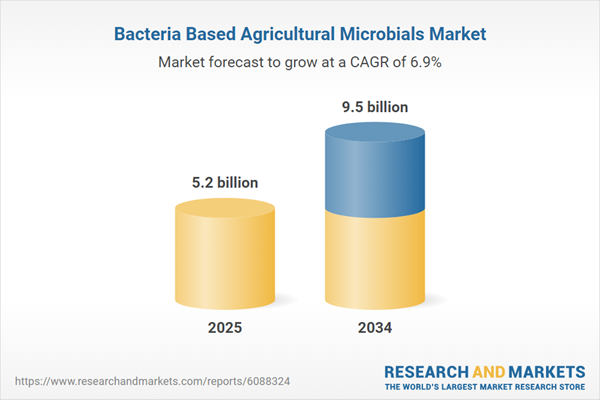Bacteria Based Agricultural Microbials Research Report – GlobeNewswire


Global Bacteria-Based Agricultural Microbials Market Report 2025-2034
Market Overview and Sustainable Development Goals (SDGs) Alignment
The global bacteria-based agricultural microbials market is projected to grow from USD 5.2 billion in 2025 to USD 9.5 billion by 2034, exhibiting a compound annual growth rate (CAGR) of 6.9%. This growth is driven by the increasing adoption of sustainable agricultural practices, which directly contribute to several United Nations Sustainable Development Goals (SDGs), including:
- SDG 2: Zero Hunger – Enhancing crop yields through eco-friendly microbial solutions.
- SDG 12: Responsible Consumption and Production – Promoting organic farming and reducing chemical inputs.
- SDG 13: Climate Action – Minimizing environmental impact by replacing conventional fertilizers and pesticides.
- SDG 15: Life on Land – Improving soil health and biodiversity via microbial soil treatments.
Key Market Drivers and Trends Supporting SDGs
- Sustainable Farming Practices: The shift towards sustainable agriculture reduces reliance on harmful chemicals, aligning with SDG 12 and SDG 15.
- Organic Product Demand: Rising consumer preference for organic and sustainably sourced food supports SDG 2 and SDG 3 (Good Health and Well-being).
- Soil Health Management: Emphasis on soil microbiomes enhances long-term agricultural productivity, supporting SDG 15.
- Technological Advancements: Development of superior bacterial strains and integration with precision agriculture and digital tools improve product efficacy and resource efficiency, advancing SDG 9 (Industry, Innovation, and Infrastructure).
- Regulatory Support and Collaborations: Government incentives and partnerships among manufacturers, research institutions, and digital platforms encourage sustainable innovation consistent with SDG 17 (Partnerships for the Goals).
Market Segmentation
- By Type: Bacillus Thuringiensis, Rhizobium, Bacillus Subtilis, Others
- By Formulation: Dry, Liquid
- By Mode of Application: Soil Treatment, Foliar Spray, Seed Treatment
- By Application: Cereals and Grains, Oilseeds and Pulses, Fruits and Vegetables, Turf and Ornamentals
- By Geography: North America, Europe, Asia-Pacific, Middle East and Africa, South and Central America
Challenges Impacting Market Growth
- High initial investment costs and limited awareness among smallholder farmers hinder widespread adoption, affecting SDG 1 (No Poverty) and SDG 2.
- Logistical and storage requirements for live microbial products present scalability challenges.
Regional Market Opportunities
Emerging markets in Asia-Pacific and Latin America are expected to benefit significantly from sustainable and cost-effective farming solutions, contributing to SDG 1, SDG 2, and SDG 8 (Decent Work and Economic Growth) by supporting smallholder farmers and rural economies.
Report Attributes
| Attribute | Details |
|---|---|
| Number of Pages | 150 |
| Forecast Period | 2025 – 2034 |
| Estimated Market Value (2025) | USD 5.2 Billion |
| Forecasted Market Value (2034) | USD 9.5 Billion |
| Compound Annual Growth Rate (CAGR) | 6.9% |
| Regions Covered | Global |
Key Insights
- Comprehensive global and regional market outlook with size, share, and trends from 2025 to 2034.
- Impact analysis of geopolitical, economic, and trade policies on demand and supply chains.
- Detailed market segmentation and dynamics including drivers, restraints, and opportunities aligned with SDGs.
- Profiles of leading companies and competitive strategies fostering sustainable agricultural innovation.
Leading Companies in the Market
- BASF SE
- Bayer AG
- Certis LLC
- Isagro S.p.A.
- Verdesian Life Sciences LLC
- Koppert B.V.
- E.I. DuPont de Nemours and Company
- Syngenta AG
- Sumitomo Chemical Co. Ltd.
- Corteva Inc.
- CHR. Hansen Holdings A/S
- UPL Limited
- Valent Biosciences Corporation
- Novozymes A/S
- Gujarat State Fertilizers & Chemicals Limited
- Marrone Bio Innovations Inc.
- Nufarm Ltd.
- Precision Laboratories LLC
- Lallemand Inc.
- BioWorks Inc.
- Terramera Inc.
- Andermatt Biocontrol AG
- BioConsortia Inc.
- BioPhero ApS
- Biotalys NV
- BioTEPP Inc.
- EcoPesticides International Inc.
- Futureco Bioscience S.A.
- Gowan Company LLC
- Kemin Industries Inc.
- Plant Health Care plc
- Symborg SL
Conclusion
The bacteria-based agricultural microbials market represents a critical component in advancing sustainable agriculture and achieving multiple SDGs. Continued innovation, supportive policies, and increased awareness will be essential to overcoming challenges and maximizing the environmental and economic benefits of microbial solutions in farming worldwide.
For more detailed information, visit the full report at ResearchAndMarkets.com.
1. Sustainable Development Goals (SDGs) Addressed or Connected
- SDG 2: Zero Hunger
- The article discusses improving crop yields and sustainable farming practices, which directly relate to ending hunger and achieving food security.
- SDG 12: Responsible Consumption and Production
- Promotion of organic products and sustainable agricultural inputs aligns with responsible production and consumption patterns.
- SDG 13: Climate Action
- Use of eco-friendly bacteria-based microbials reduces reliance on chemical fertilizers and pesticides, contributing to climate mitigation efforts.
- SDG 15: Life on Land
- Focus on soil health management and microbiomes supports sustainable land use and ecosystem preservation.
- SDG 9: Industry, Innovation and Infrastructure
- Advancements in microbial technologies and integration with digital platforms highlight innovation in agriculture.
2. Specific Targets Under Identified SDGs
- SDG 2: Zero Hunger
- Target 2.3: By 2030, double the agricultural productivity and incomes of small-scale food producers through sustainable practices.
- Target 2.4: Ensure sustainable food production systems and implement resilient agricultural practices.
- SDG 12: Responsible Consumption and Production
- Target 12.2: Achieve sustainable management and efficient use of natural resources.
- Target 12.4: Environmentally sound management of chemicals and wastes to minimize adverse impacts.
- SDG 13: Climate Action
- Target 13.1: Strengthen resilience and adaptive capacity to climate-related hazards and natural disasters.
- SDG 15: Life on Land
- Target 15.3: Combat desertification, restore degraded land and soil.
- Target 15.5: Protect biodiversity and natural habitats.
- SDG 9: Industry, Innovation and Infrastructure
- Target 9.5: Enhance scientific research and upgrade technological capabilities.
3. Indicators Mentioned or Implied to Measure Progress
- Market Size and Growth
- Market value projections (USD 5.2 billion in 2025 to USD 9.5 billion by 2034) and CAGR of 6.9% indicate adoption and economic impact of sustainable agricultural microbials.
- Adoption Rates of Sustainable Practices
- Increased use of bacteria-based microbials as an alternative to chemical inputs reflects progress towards sustainable farming targets.
- Soil Health and Crop Yields
- Improvement in soil microbiomes and crop productivity are implied indicators for sustainable agriculture and land restoration.
- Regulatory Support and Innovation
- Emergence of supportive regulations and technological advancements serve as indicators of enabling environments for sustainable agriculture.
4. Table: SDGs, Targets and Indicators
| SDGs | Targets | Indicators |
|---|---|---|
| SDG 2: Zero Hunger |
|
|
| SDG 12: Responsible Consumption and Production |
|
|
| SDG 13: Climate Action |
|
|
| SDG 15: Life on Land |
|
|
| SDG 9: Industry, Innovation and Infrastructure |
|
|
Source: globenewswire.com








